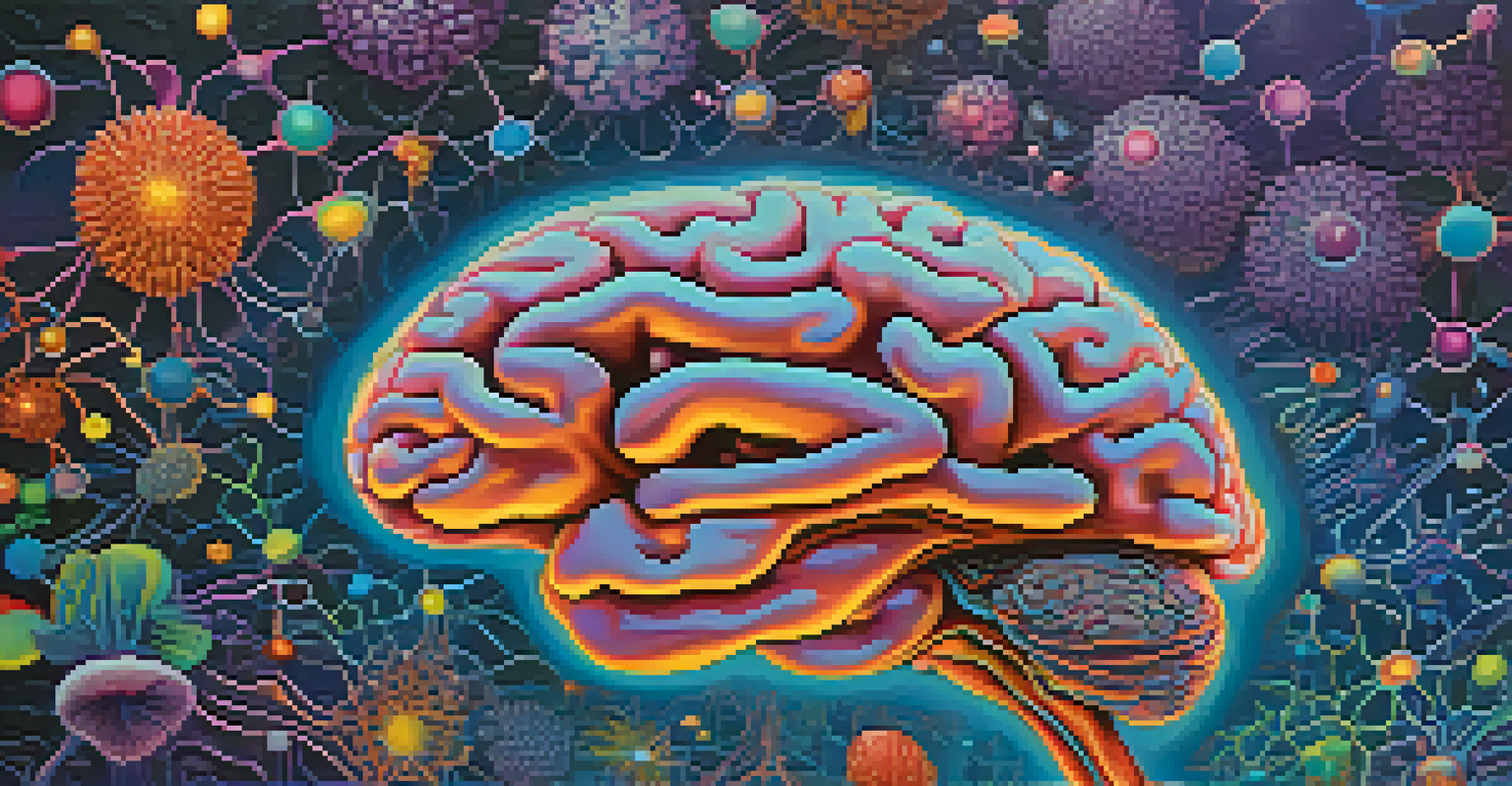Investigating Psychedelics: Aging and Neuroplasticity

Understanding Aging: A Journey Through the Brain
Aging is often viewed as a decline in cognitive function and neural connectivity. As we age, our brains undergo significant changes, such as reduced neuroplasticity, which is the brain's ability to adapt and reorganize itself. This decline can lead to memory loss and difficulties in learning new information.
The greatest discovery of my generation is that a human being can alter his life by altering his attitude.
However, aging is not solely negative; it also brings wisdom and experience. The challenge lies in balancing the inevitable changes with methods to enhance cognitive resilience. Understanding how our brains age sets the stage for exploring potential interventions.
One such intervention that has gained attention is psychedelics. These substances, often associated with recreational use, are being investigated for their therapeutic potential, particularly in relation to neuroplasticity and cognitive aging.
Psychedelics 101: What Are They and How Do They Work?
Psychedelics are a class of compounds that alter perception, mood, and various cognitive processes. Common examples include psilocybin (found in magic mushrooms) and LSD. These substances are known to interact with serotonin receptors in the brain, leading to profound changes in consciousness and perception.

But beyond the mind-altering experiences, psychedelics have been shown to promote neuroplasticity. Research suggests that they may encourage the growth of new neurons and synaptic connections, which can be especially beneficial in aging brains. This opens up exciting possibilities for improving cognitive health.
Psychedelics May Boost Neuroplasticity
Research suggests that psychedelics like psilocybin can enhance neuroplasticity, potentially improving cognitive function in aging populations.
By understanding the basic mechanisms of psychedelics, we can appreciate their potential role in combating age-related cognitive decline and fostering mental flexibility.
The Science of Neuroplasticity: A Lifelong Ability
Neuroplasticity is the brain's remarkable ability to reorganize itself by forming new neural connections. This process occurs throughout our lives, enabling us to learn, adapt, and recover from injuries. However, factors such as age, stress, and trauma can hinder neuroplasticity, making it more challenging for the brain to adapt.
Aging is not lost youth but a new stage of opportunity and strength.
Research shows that engaging in stimulating activities, such as learning new skills or practicing mindfulness, can enhance neuroplasticity. When we combine these practices with psychedelics, the potential for cognitive rejuvenation becomes even more intriguing. The interplay between psychedelics and neuroplasticity is an area ripe for exploration.
Unlocking the secrets of neuroplasticity could lead us to innovative therapies for age-related cognitive decline, making the study of psychedelics even more significant in this context.
Psychedelics and Their Potential to Enhance Neuroplasticity
Emerging research highlights the potential of psychedelics to enhance neuroplasticity significantly. Studies suggest that substances like psilocybin can stimulate the production of brain-derived neurotrophic factor (BDNF), a protein that supports neuron growth and survival. Increased BDNF levels may lead to improved cognitive function, especially in older adults.
This newfound understanding positions psychedelics as potential tools for fostering cognitive resilience in aging populations. By promoting neuroplasticity, these substances could help mitigate the negative effects of aging on mental health and cognitive abilities.
Therapeutic Use in Cognitive Rehab
Psychedelics are being explored for their therapeutic potential, particularly in assisting cognitive rehabilitation for older adults recovering from brain injuries.
While the results are promising, more research is needed to fully understand the mechanisms at play and to develop safe, effective treatments.
Real-World Applications: Psychedelics in Therapy
The therapeutic use of psychedelics is gaining traction in mental health treatment, with clinical trials exploring their effects on conditions like depression, anxiety, and PTSD. The potential for these substances to enhance neuroplasticity could also extend to cognitive rehabilitation for older adults.
For instance, individuals recovering from stroke or traumatic brain injury may benefit from psychedelic-assisted therapy, which could promote neural healing and cognitive recovery. This application highlights the versatility of psychedelics in addressing various cognitive challenges.
As we continue to explore their therapeutic potential, it's essential to approach this field with caution and respect, prioritizing safety and ethical considerations.
Challenges and Considerations in Psychedelic Research
Despite the promising findings, researching psychedelics comes with its challenges. Legal restrictions and societal stigma surrounding these substances can hinder research efforts, making it difficult to conduct comprehensive studies. Additionally, the variability in individual responses to psychedelics adds another layer of complexity.
Safety is another crucial consideration. While many studies report minimal adverse effects, the potential for negative psychological experiences exists, especially in unsupervised settings. Therefore, rigorous clinical protocols and trained facilitators are essential for ensuring participant safety.
Challenges in Psychedelic Research
Legal restrictions and individual variability present challenges in psychedelic research, emphasizing the need for safe and ethical exploration.
Navigating these challenges requires collaboration between researchers, policymakers, and mental health professionals to create a framework that allows for safe exploration of psychedelics in aging and neuroplasticity.
Looking Ahead: The Future of Psychedelics and Aging
As research into psychedelics progresses, the future holds exciting possibilities for their application in aging and cognitive health. The potential to enhance neuroplasticity could revolutionize how we approach aging, focusing on enhancing quality of life rather than solely managing decline.
Innovative therapies that incorporate psychedelics may offer new hope to older adults struggling with cognitive challenges, promoting not just recovery but also growth. This shift in perspective could lead to a more holistic approach to aging, emphasizing adaptability and resilience.

Ultimately, continued investigation into psychedelics will pave the way for breakthroughs that could significantly impact aging populations, unlocking new avenues for mental health and cognitive enhancement.